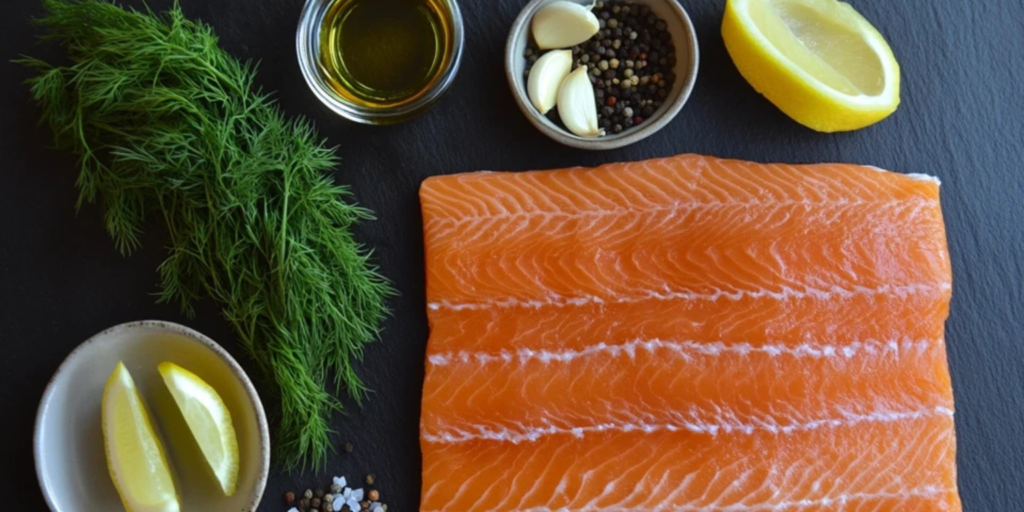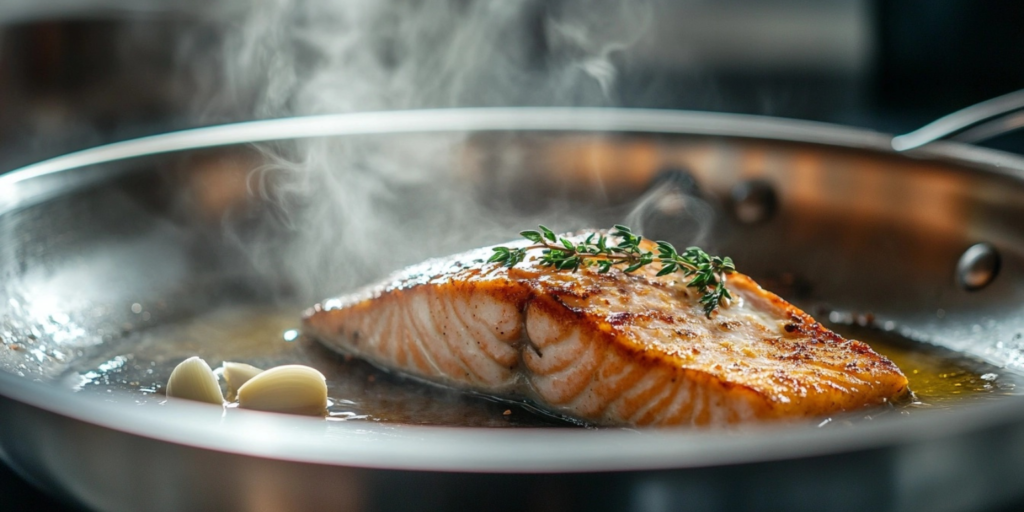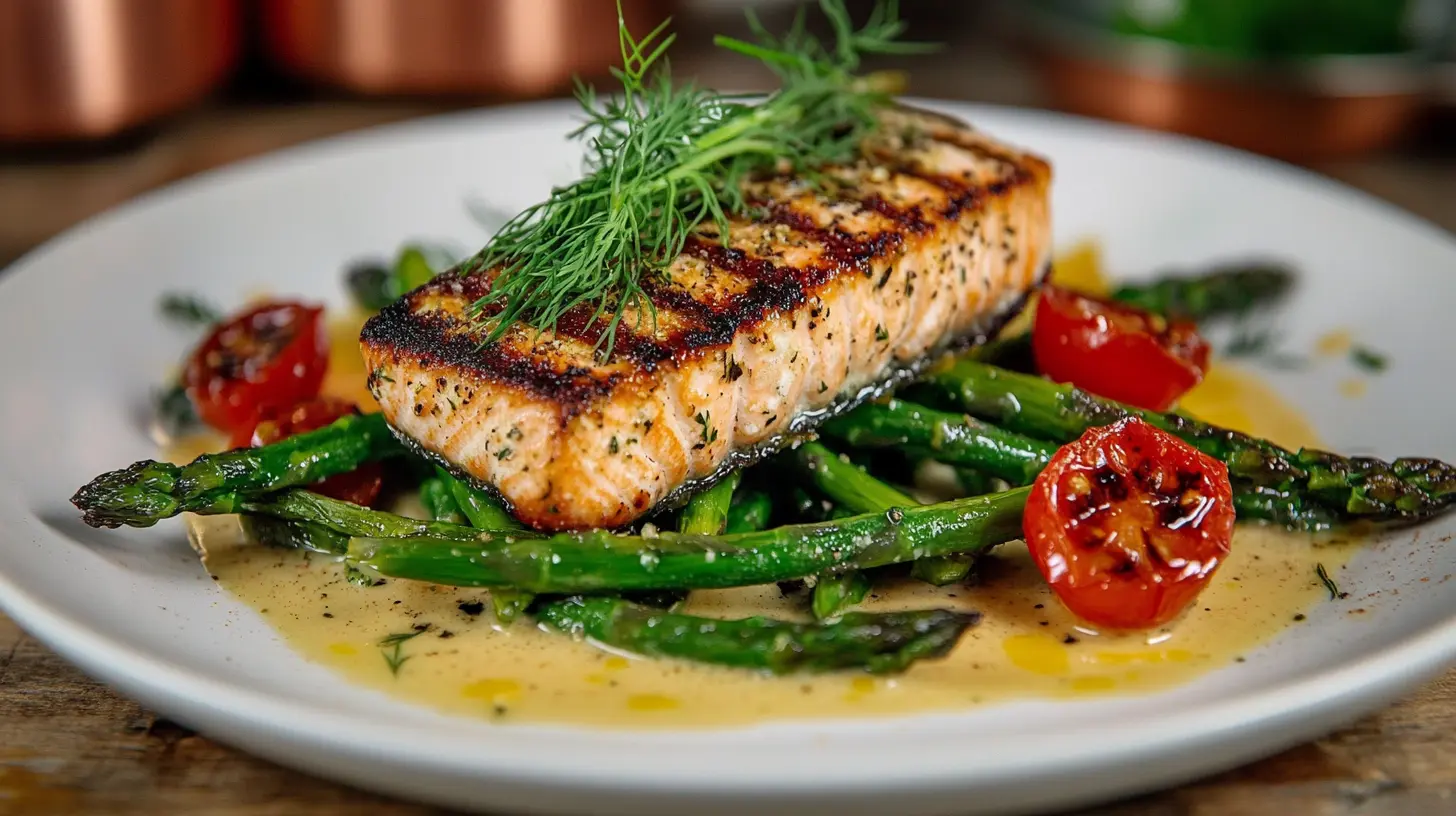Introduction
Gordon Ramsay’s Signature Approach to Salmon
When it comes to cooking salmon, few chefs bring the same level of artistry and expertise as Gordon Ramsay. Renowned for his innovative techniques and attention to detail, Ramsay emphasizes flavor, texture, and presentation when preparing this popular fish. A hallmark of his method is creating a balance of seasoning that enhances the natural richness of salmon without overpowering it. He often incorporates fresh herbs, zesty citrus, and just the right amount of seasoning to elevate the dish to restaurant-quality perfection. But what truly sets his approach apart is his precision in cooking—ensuring the salmon stays moist and flaky with a crispy, golden sear on the outside.
Table of Contents
Why Salmon Deserves Special Attention
Salmon is not just a delicious fish—it’s also one of the most versatile proteins you can work with. Packed with omega-3 fatty acids, high-quality protein, and a range of vitamins and minerals, salmon earns its place as a staple in both everyday meals and gourmet dining. Preparing salmon correctly is essential to highlight its natural flavors and health benefits. Gordon Ramsay understands this better than anyone, which is why his techniques focus on maintaining the fish’s delicate texture while enhancing its taste. This careful approach makes his recipes a go-to choice for anyone looking to prepare a standout salmon dish.
The Perfect Seasoning Balance
What does Gordon Ramsay put on salmon to make it so unforgettable? It’s all about creating a seasoning blend that complements the fish’s natural flavors. Ramsay typically starts with a pinch of sea salt and freshly cracked black pepper, followed by layers of flavor that include fresh dill, parsley, or thyme. A splash of lemon or lime juice brightens the dish, while olive oil or butter ensures a luscious finish. Depending on the recipe, he might add a touch of garlic, paprika, or Dijon mustard for a bold kick. These simple yet effective ingredients transform a standard salmon dish into an extraordinary culinary experience.
Recipe History
Gordon Ramsay’s Influence on Salmon Recipes
Gordon Ramsay has left an undeniable mark on the culinary world, and his salmon recipes are a testament to his skill and creativity. Over the years, Ramsay has elevated salmon from a simple ingredient to a centerpiece of gourmet cooking. Whether featured in his Michelin-starred restaurants or showcased on his popular cooking shows, his methods have inspired home cooks and professional chefs alike. By focusing on premium ingredients and refined techniques, Ramsay has redefined how salmon is prepared and served, making it approachable yet elegant.
The Evolution of Salmon Seasoning Techniques
Seasoning salmon has come a long way, with chefs across the globe experimenting with bold flavors and textures. Gordon Ramsay’s approach combines classic seasoning methods with a modern twist, giving his recipes an edge. Traditionally, salmon was prepared with basic salt, pepper, and butter. Ramsay, however, introduced the concept of layering flavors using fresh herbs, zesty citrus, and innovative glazes like honey mustard or miso. This evolution has influenced countless salmon recipes, proving that simplicity and sophistication can go hand in hand.
The Popularity of Gordon Ramsay’s Salmon Recipes
Part of what makes Gordon Ramsay’s salmon recipes so iconic is their widespread appeal. Whether you’re watching him effortlessly sear a fillet on TV or recreating one of his dishes at home, his recipes are known for delivering consistent, high-quality results. The popularity of these recipes has grown thanks to their simplicity and the emphasis on using fresh, readily available ingredients. Ramsay’s salmon dishes are celebrated for their ability to balance health-conscious choices with indulgent flavors, making them a favorite for both novice cooks and culinary experts.
Health Benefits of This Recipe
Nutritional Benefits of Salmon
Salmon is a nutritional powerhouse, making it a favorite among health enthusiasts and food lovers alike. Rich in omega-3 fatty acids, it promotes heart health, reduces inflammation, and supports brain function. It’s also an excellent source of high-quality protein, helping with muscle repair and growth. Vitamins like B12 and D, as well as minerals like selenium and potassium, contribute to overall well-being. Gordon Ramsay’s salmon recipes not only maximize flavor but also retain the fish’s natural nutrients, offering a meal that’s as healthy as it is delicious.
Health Advantages of Gordon Ramsay’s Techniques
Gordon Ramsay’s cooking methods emphasize both taste and health, making his salmon recipes an excellent choice for those looking to eat well. By avoiding heavy sauces and opting for lighter ingredients like fresh herbs, olive oil, and citrus, Ramsay ensures his dishes are nutrient-dense and low in unnecessary fats. Cooking techniques like pan-searing and oven-baking lock in the fish’s natural oils, preserving its health benefits without compromising flavor.
Why Salmon and Asparagus Are a Perfect Match
Pairing salmon with asparagus isn’t just a culinary choice—it’s a nutritional one. Asparagus is loaded with vitamins A, C, and K, as well as fiber, making it a perfect complement to the nutrient-rich salmon. Together, they create a well-rounded meal that supports digestion, boosts immunity, and provides a low-calorie yet filling option. This pairing, often highlighted in Gordon Ramsay’s recipes, offers the ideal balance of flavor, texture, and health benefits.
Low-Calorie Options with Salmon
For those looking to maintain or lose weight, salmon is an excellent option. Its high protein content keeps you feeling full, while its healthy fats provide lasting energy. Gordon Ramsay’s recipes often include simple, low-calorie preparations that avoid unnecessary sugars or oils. By combining salmon with light sides like steamed vegetables or a fresh salad, you can enjoy a satisfying meal that aligns with your health goals.
Ingredients and Preparation
What Gordon Ramsay Uses for His Salmon
When preparing salmon, Gordon Ramsay emphasizes high-quality ingredients to elevate the dish. For the fish itself, he selects fresh, wild-caught salmon for its superior flavor and texture. Key seasonings include coarse sea salt and freshly cracked black pepper, which enhance the fish’s natural taste. Ramsay often incorporates fresh herbs like dill, parsley, or thyme, paired with a splash of lemon or lime juice for brightness. A drizzle of olive oil or a knob of butter ensures the salmon remains moist during cooking. These simple yet refined ingredients create the foundation for a world-class salmon dish.

Step-by-Step Preparation of Salmon and Asparagus
To recreate Gordon Ramsay’s famous salmon with asparagus, start by preparing the salmon fillet. Pat the fish dry with paper towels and season generously with salt and pepper on both sides. Heat a pan with olive oil over medium-high heat and place the salmon skin-side down, cooking until the skin is crispy. For the asparagus, blanch the spears in boiling water for a minute, then transfer them to an ice bath to maintain their vibrant color. Sauté the asparagus in the same pan as the salmon with a touch of garlic and olive oil for added flavor. Serve the salmon atop the asparagus for a beautifully plated dish.
Key Ingredients for Ramsay’s Signature Salmon
The success of Gordon Ramsay’s salmon recipes lies in his thoughtful selection of ingredients. Alongside the salmon, he uses pantry staples like olive oil, garlic, and lemon, as well as fresh herbs for added depth of flavor. For more adventurous recipes, Ramsay may include Dijon mustard, soy sauce, or even a honey glaze to add complexity. Each ingredient is chosen with care to enhance the salmon’s natural richness while keeping the dish balanced and elegant.
Choosing the Best Salmon Cuts
Selecting the right cut of salmon is crucial to achieving restaurant-quality results. Gordon Ramsay typically uses fillets with the skin on, as the skin helps retain moisture during cooking and adds a crispy texture when seared. Look for vibrant, firm flesh with no off-putting smell to ensure freshness. If you’re feeding a crowd, a whole side of salmon can be an impressive option, while individual fillets work best for smaller servings. Ramsay’s attention to detail in ingredient selection ensures every dish starts with the best possible foundation.
Serving Suggestions
Plating Salmon Like Gordon Ramsay
Presentation is key when it comes to any Gordon Ramsay dish, and his salmon recipes are no exception. To plate salmon like a pro, start with a clean, minimalist base. Place the asparagus spears neatly on the plate as a foundation and carefully rest the salmon fillet on top, skin-side up for a crispy visual appeal. Add a drizzle of lemon-infused olive oil around the edges for a gourmet touch. Garnish with fresh herbs like dill or parsley for a pop of color, and finish with a light sprinkle of sea salt for added texture. This approach creates a visually stunning dish that looks as good as it tastes.
Pairing Salmon with Asparagus
Salmon and asparagus are a match made in culinary heaven, offering complementary flavors and textures. The rich, flaky salmon pairs beautifully with the crisp, earthy notes of asparagus. To elevate this pairing, you can add a side of roasted baby potatoes, a zesty lemon butter sauce, or even a light quinoa salad. Gordon Ramsay often emphasizes balance on the plate, so make sure the sides you choose enhance, rather than overshadow, the salmon and asparagus.
Adding Complementary Sides to Your Meal
For a well-rounded meal, consider pairing salmon with sides that add contrasting flavors and textures. Creamy mashed potatoes or a wild rice pilaf are hearty options that balance the lightness of the fish. If you prefer a lighter pairing, a fresh cucumber and dill salad or a citrusy arugula mix works perfectly. Ramsay often recommends sides that provide a touch of acidity or crunch to round out the dish, ensuring every bite is satisfying and dynamic.
Elevating the Dish with Garnishes
Garnishes can transform a simple salmon dish into a show-stopping plate. For a classic Gordon Ramsay touch, try a dollop of crème fraîche with a hint of horseradish, or a sprinkle of microgreens for a fresh, modern twist. Citrus zest adds brightness, while toasted almonds or pine nuts introduce a crunchy element. These small, thoughtful additions not only enhance the visual appeal but also elevate the overall flavor profile of the dish.
Cooking Techniques
How Gordon Ramsay Cooks Salmon to Perfection
Gordon Ramsay’s method for cooking salmon focuses on achieving the perfect texture—crispy on the outside and tender on the inside. He begins by heating a non-stick pan over medium-high heat and adding a drizzle of olive oil. The salmon fillet is placed skin-side down, pressed gently with a spatula to ensure even contact with the pan. This step creates a beautifully crispy skin. Once the salmon is nearly cooked through, Ramsay flips it for just 30 seconds to sear the top, leaving the interior flaky and moist. This technique guarantees a restaurant-quality result every time.
Tips for Cooking Salmon Without Overcooking
Overcooked salmon can become dry and unappetizing, but Gordon Ramsay’s techniques ensure the fish stays juicy and flavorful. Start by using medium-high heat to quickly sear the outside without cooking the interior too fast. Use a thermometer to check the internal temperature—125°F is ideal for perfectly cooked salmon. Resting the salmon for a minute after removing it from the heat allows the residual heat to finish cooking the fish gently. Ramsay also recommends avoiding excessive handling of the fillet to prevent breaking apart the delicate flesh.

Oven-Baking Gordon Ramsay Style
Oven-baking is one of Gordon Ramsay’s go-to methods for cooking salmon, especially when serving larger portions. Preheat the oven to 400°F and line a baking tray with parchment paper. Season the salmon with salt, pepper, and a drizzle of olive oil, then add fresh herbs and citrus slices for flavor. Bake the salmon skin-side down for about 12-15 minutes, depending on the thickness of the fillet. This method locks in moisture and creates an evenly cooked, tender result. For an added touch, finish with a quick broil to crisp the top.
Mastering Pan-Seared Salmon
Pan-searing is one of the fastest and most flavorful ways to prepare salmon. Ramsay starts by ensuring the fillet is dry to achieve a good sear. Heat a pan over medium-high heat with a tablespoon of olive oil. Place the salmon skin-side down and cook undisturbed for 3-4 minutes, allowing the skin to become golden and crispy. Flip the fillet carefully and sear the flesh side for just 1-2 minutes. Basting the salmon with melted butter infused with garlic and herbs during the final moments of cooking adds depth and richness to the flavor.
FAQ
Is Salmon and Asparagus Good for You?
Absolutely! Salmon and asparagus make a nutrient-packed pairing that’s both delicious and healthy. Salmon is loaded with omega-3 fatty acids, which support heart health and brain function, as well as high-quality protein to promote muscle repair and growth. Asparagus, on the other hand, is an excellent source of fiber, vitamins A, C, and K, and folate. Together, they create a low-calorie, nutrient-dense meal that’s ideal for maintaining a healthy lifestyle. This combination is often highlighted in Gordon Ramsay’s recipes for its balance of flavor and nutrition.
What to Season Salmon with Before Baking?
When baking salmon, seasoning plays a crucial role in enhancing its natural flavor. Gordon Ramsay recommends starting with a simple base of sea salt and freshly cracked black pepper. From there, you can add fresh herbs like dill or parsley, a splash of lemon juice, and a drizzle of olive oil to keep the fish moist. For a bolder flavor, try incorporating Dijon mustard, paprika, or even a honey glaze. These ingredients complement the richness of the salmon and bring out its delicate taste when baked.
How to Cook and Eat Salmon?
Cooking salmon can be simple and rewarding if done right. Start by choosing a fresh fillet with vibrant color and firm texture. Popular cooking methods include pan-searing, oven-baking, or grilling. For Gordon Ramsay’s style, focus on techniques that retain moisture while creating a crispy exterior. When eating salmon, the skin can be enjoyed if it’s properly seared, adding a delightful crunch. Pair it with complementary sides like asparagus or roasted vegetables for a complete meal. Don’t forget to garnish with fresh herbs or a squeeze of citrus for a bright finish.
Why Is Salmon So Popular in Gourmet Cooking?
Salmon’s popularity in gourmet cooking is due to its versatility, rich flavor, and health benefits. Its high fat content allows it to stay moist during various cooking methods, while its mild taste pairs well with countless seasonings and sauces. Renowned chefs like Gordon Ramsay favor salmon for its ability to shine as the centerpiece of a dish. Whether served with a light herb dressing or an elaborate glaze, salmon adapts effortlessly to both casual and fine dining, making it a favorite in kitchens worldwide.
Conclusion
Unlocking the Secrets to Salmon Perfection
Cooking salmon like Gordon Ramsay is about embracing simple, high-quality ingredients and mastering precise techniques. By balancing seasoning, using fresh herbs, and employing methods like pan-searing or oven-baking, you can achieve restaurant-quality results at home. Ramsay’s approach highlights the natural richness of salmon while enhancing its flavors with thoughtful additions. Whether you’re an experienced chef or a home cook, unlocking these secrets will take your salmon dishes to the next level.
Why Gordon Ramsay’s Salmon Stands Out
What makes Gordon Ramsay’s salmon recipes so exceptional is the attention to detail in every step. From choosing the best cuts to layering flavors and cooking with precision, Ramsay’s techniques ensure consistently perfect results. His recipes not only elevate the fish but also inspire confidence in the kitchen. The combination of crispy skin, flaky flesh, and perfectly balanced seasoning creates a dish that’s both indulgent and nutritious. By following his methods, you can bring a touch of gourmet magic to your dinner table.
Incorporating Professional Techniques at Home
You don’t need a Michelin-starred kitchen to cook like Gordon Ramsay. His salmon recipes focus on accessible ingredients and straightforward techniques, making them achievable for home cooks. Start by selecting fresh salmon, seasoning it simply, and following Ramsay’s expert cooking tips. Pair it with sides like asparagus or a fresh salad for a balanced, flavorful meal. With a little practice, you’ll be able to incorporate professional techniques that impress family and friends while enjoying the health benefits of a gourmet dish.
Discover the best ways to Season Salmon Before Baking for maximum flavor.
Check out our Pasta with Asparagus and Salmon for another delicious way to pair these two ingredients.
Learn more about the benefits of How to Cook and Eat Salmon? in your diet.
